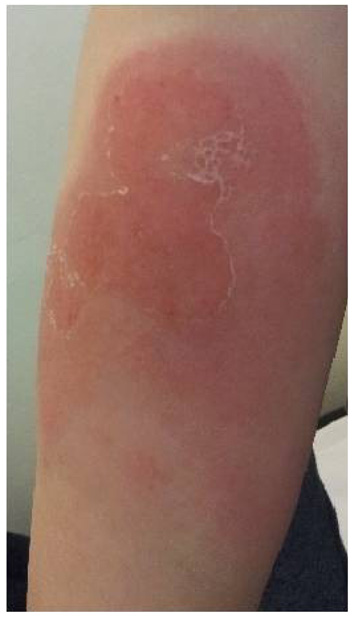Obstet Gynecol Sci.
2014 Jul;57(4):314-317. 10.5468/ogs.2014.57.4.314.
Successful management of maternal factor VII deficiency in a cesarean section
- Affiliations
-
- 1Department of Obstetrics and Gynecology, University of Ulsan College of Medicine, Gangneung Asan Hospital, Gangneung, Korea. dhju@gnah.co.kr
- KMID: 1841544
- DOI: http://doi.org/10.5468/ogs.2014.57.4.314
Abstract
- Factor VII (FVII) deficiency is an infrequent hereditary bleeding disorder that can make excessive bleeding in surgical interventions, such as a postpartum hemorrhage in a cesarean section. Although a recombinant form of activated FVII has been applied for bleeding control in FVII-deficient patients, its applications in the field of obstetrics are still limited, especially in Korea. Replacement of blood products is still preferred as first-line therapy, with antifibrinolytic agents used as adjunctive therapy. We report herein the case of a successful cesarean section in an 18-year-old woman with FVII deficiency.
MeSH Terms
Figure
Reference
-
1. Herrmann FH, Wulff K, Auerswald G, Schulman S, Astermark J, Batorova A, et al. Factor VII deficiency: clinical manifestation of 717 subjects from Europe and Latin America with mutations in the factor 7 gene. Haemophilia. 2009; 15:267–280.2. Osterud B. Factor VII and haemostasis. Blood Coagul Fibrinolysis. 1990; 1:175–181.3. Korea Hemophilia Foundation. Annual report 2010. Seoul: Korea Hemophilia Foundation;2011.4. Mariani G, Herrmann FH, Dolce A, Batorova A, Etro D, Peyvandi F, et al. Clinical phenotypes and factor VII genotype in congenital factor VII deficiency. Thromb Haemost. 2005; 93:481–487.5. Benlakhal F, Mura T, Schved JF, Giansily-Blaizot M. A retrospective analysis of 157 surgical procedures performed without replacement therapy in 83 unrelated factor VII-deficient patients. J Thromb Haemost. 2011; 9:1149–1156.6. Giansily-Blaizot M, Biron-Andreani C, Aguilar-Martinez P, de Moeloose P, Briquel ME, Goudemand J, et al. Inherited factor VII deficiency and surgery: clinical data are the best criteria to predict the risk of bleeding. Br J Haematol. 2002; 117:172–175.7. Kim BJ, Lee CH, Kim YH, Cho JS, Park YW. A case of vaginal delivery in woman with congenital factor V deficiency. Korean J Obstet Gynecol. 2002; 45:873–877.8. Pike GN, Bolton-Maggs PH. Factor deficiencies in pregnancy. Hematol Oncol Clin North Am. 2011; 25:359–378.9. Kwon MJ, Yoo KY, Lee KO, Kim SH, Kim HJ. Recurrent mutations and genotype-phenotype correlations in hereditary factor VII deficiency in Korea. Blood Coagul Fibrinolysis. 2011; 22:102–105.10. Brummel Ziedins K, Rivard GE, Pouliot RL, Butenas S, Gissel M, Parhami-Seren B, et al. Factor VIIa replacement therapy in factor VII deficiency. J Thromb Haemost. 2004; 2:1735–1744.11. Baumann Kreuziger LM, Morton CT, Reding MT. Is prophylaxis required for delivery in women with factor VII deficiency? Haemophilia. 2013; 19:827–832.12. Kim TH, Lee HH, Kim JM, Ryu AL, Chung SH, Seok Lee W. Uterine artery embolization for primary postpartum hemorrhage. Iran J Reprod Med. 2013; 11:511–518.13. Kobayashi T, Nakabayashi M, Yoshioka A, Maeda M, Ikenoue T. Recombinant activated factor VII (rFVIIa/NovoSeven(R)) in the management of severe postpartum haemorrhage: initial report of a multicentre case series in Japan. Int J Hematol. 2012; 95:57–63.14. Lapecorella M, Mariani G. Factor VII deficiency: defining the clinical picture and optimizing therapeutic options. Haemophilia. 2008; 14:1170–1175.15. Srivastava A, Brewer AK, Mauser-Bunschoten EP, Key NS, Kitchen S, Llinas A, et al. Guidelines for the management of hemophilia. Haemophilia. 2013; 19:e1–e47.
- Full Text Links
- Actions
-
Cited
- CITED
-
- Close
- Share
- Similar articles
-
- Orthognathic Surgery in a Patient with Factor VII Deficiency
- Four cases report of congenital factor VII deficiency
- A Case of Successful Treatment of Childhood Intractable Gastrointestinal Hemorrhage with Low Dose Recombinant Activated Factor VII (NovoSeven (R))
- A Case of Congenital Factor VII Deficiency Presented with Subacute Subdural Hematoma
- A Case of Intractable Gastrointestinal Bleeding during Chemotherapy in Hereditary Coagulation Factor Deficiency



